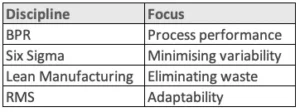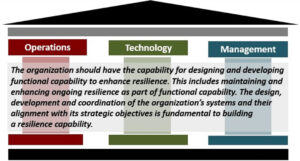A couple of years ago, in a fast-growing convenience retail company, I took on a new responsibility – operations. As a newly-appointed Operations Director, I was overwhelmed with the details of how individual processes work, urgent high-risk escalations, and expert advice on what should be done immediately. Improvements to individual processes were a low-hanging fruit, and it was tempting to get lost in pursuing them. But rarely did the processes work according to their intended design. Minor improvements were quite easy to achieve, but changes introduced to the company were so frequent (new outlets, new product lines, new vendors, new technology, new teams, new geographic regions …), that every process design used to become obsolete very quickly. Retail companies are incredibly process-driven. In our case, everybody just followed “the steps” without asking simple questions: “who is the recipient of this task?”, “why are we doing this”, “how can we improve?” The culture was siloed, so the communication flows stagnated. Even when employees on-site had bright ideas and offered solutions, they were simply unable to reach decision-makers. Due to their feeling of helplessness in solving daily challenges, their motivation deteriorated over time. It took me a while to realise that the incremental improvements we were achieving were insignificant compared to the immense potential for change. But, as I was indeed achieving efficiency gains, it was hard to see what was missing in my approach. Most organisations today operate in a rapidly-changing environment. Minor inefficiencies caused by static processes, accumulated over time, propagate and lead to unexpected excess spending, losses or simply increased risks. Yes, many companies incorporate continuous improvement practices, but they tend to be triggered according to a schedule, and not necessarily on a real-time basis.
Beyond Traditional Operations
Traditional operations disciplines such as Business Process Redesign (BPR), Six Sigma, Lean Manufacturing, and Reconfigurable Manufacturing System (RMS) can be effective in increasing efficiency, but they tend to focus on isolated elements of the organisation.
 Comparison between the four operational disciplines
Comparison between the four operational disciplines
Although each discipline contributes to operational excellence in its own way, they all overlook the larger picture of interconnection, failing to recognise that optimisation in one area might result in sub-optimisation in another. Systems thinking, on the other hand, offers a holistic perspective to the table, recognising that no component of an organisation acts in isolation. It sees an organisation as an interconnected network in which changes in one element of the system can have far-reaching and often unanticipated consequences in other parts. It recognises the complexities and complexities of business, embracing the paradoxes and contradictions that other techniques may ignore.
Building resilience
The COVID-19 Pandemic proved that in an increasingly uncertain world, building organisational resilience is critical. Systems thinking improves resilience and risk management by allowing organisations to anticipate environmental and contextual changes. Understanding the interconnection of multiple components makes it easier to identify possible danger spots and snowball effects. The broad systems thinking perspective promotes resilience by empowering organisations to absorb shocks, adapt to change, and evolve continually in an increasingly uncertain world. To increase organisational preparedness, Lynnda Nelson emphasises the importance of a coordinated approach to managing risk, offering three main focus areas:

“Risk-based thinking requires organisations to evaluate risk when establishing processes, controls, and improvements. One of the most important aspects of applying risk-based thinking to your management process is to make it part of your process rather than a siloed activity”
System maps and stories
Systems mapping is one of they key tools of the systems thinker. It includes locating and mapping components in order to comprehend their relationships. These insights enable efficient interventions, policy choices, or shifts that have the potential to profoundly impact a system. Synthesis is a key aspect of a system, as Leyla Acaroglu says:
“When it comes to systems thinking, the goal is synthesis, as opposed to analysis, which is the dissection of complexity into manageable components. Analysis fits into the mechanical and reductionist worldview, where the world is broken down into parts.”
Comprehending the dynamics of complex systems can be challenging. An approach that can further enhance system mapping is storytelling explained by Houda Boulahbel. Telling stories is a simplification method, that makes information more accessible. Taking into account all components of a system, how they interact is crucial for systems thinking. Storytelling adds an emotional dimension to a system map, and helps retaining the thinking of the entire system. The potential pitfall of this approach is oversimplification. Turning a complex system into a story, risks overlooking aspects or complications that are necessary for a complete comprehension.
The core of the system: feedback loops
Feedback loops are an expression of the holistic system interconnectedness. But, for a fully functioning system, they must be intentionally built, monitored and automated. One field where inspiration for building feedback loops can be borrowed is DevOps. In DevOps, automated feedback loops have been a long established practice. They are utilised as a way to maintain productivity and speed in software delivery. Not only are these loops complex and interconnected, but they have to operate in a dynamic environment. Automation becomes a crucial enabler, especially in controlling complex systems, and cutting back on delays. By automating feedback loops in business operations, organisations may be quicker in identifying areas of improvement. Dashboards, are another vital DevOps tool that can significantly improve business operations. They are centralised, and offer a real-time visual depiction of the status, trends, and projections that can aid in quick decision-making. Team members can efficiently monitor performance, receive event notifications, and be respond to changes as they occur. Dashboards encourage data-driven decision making, but also help breaking down silos by improving communication.
Cracking the code
In turbulent times, systems thinking can be a crucial path to building organisational resilience and managing risk, not just in Operations or technology, but across the organisation. Although the traditional disciplines have harvested decades of operational excellence, unlike them, systems thinking emphasises the holistic view and interconnectedness of the entire organisation. Mapping these complex connections is important for their understanding, and adding stories is a way to learn and memorise them. These numerous connections can’t function without feedback loops, and DevOps practices such as automation and dashboards are a way to adapting and acting in real-time, but also a way to achieving communication efficiency and breaking down silos. The other key lesson we have learned from our organisational transformation work is that the switch from process-centric to service-centric ways of working and managing, when combined with a strong culture of ownership and accountability, can really help teams understand how to continuously improve their part of the puzzle. And in complex systems, when each independent agent or actor is focused on its own fitness function, whilst co-evolving with others in the wider ecosystem, this can produce powerful improvement and optimisation results.
Cover Photo by Alina Grubnyak on Unsplash

